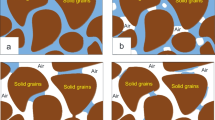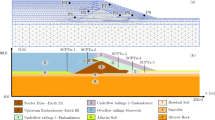Abstract
The mechanism of flow liquefaction in granular soils under drained conditions compared with that under undrained conditions is a subject of great interest. This paper discusses the diverse views in relation to the initiation of instability and the conceptual difficulties brought by the discrepancies. It is shown that the constant shear drained (CSD) stress path is not a conventional stress-controlled test, and overlooking this fact may result in misleading conclusions. The difficulties inherent in the CSD tests have resulted in different criteria for the detection of the onset of instability in experiments and thereafter to different views. Through systematic simulations for the CSD, ACU and ICU stress paths under a range of initial states, it is shown that the instability line in the stress space is state dependent, and its gradient can be well related to the state parameter defined using the critical state concepts. For a given soil, the relationship is nearly unique regardless of the CSD, ACU or ICU stress path, and the critical state concepts and the second-order work criterion work well. Theoretically, it is shown that the conditions for instability under the drained and undrained stress paths are the same, regardless of the constitutive models chosen.















Similar content being viewed by others
Abbreviations
- A, B :
-
Parameters in Eq. (1)
- A F :
-
Fabric anisotropy variable
- [C]:
-
Elastoplastic stiffness matrix in Eq. (2)
- d :
-
State-dependent dilatancy
- e 0 :
-
Void ratio after isotropic consolidation
- e A :
-
Material constant related to fabric effect
- e Γ :
-
Critical state parameter in Eq. (8)
- F d :
-
Norm of deviatoric part of fabric tensor
- G :
-
Elastic shear modulus
- K :
-
Elastic bulk modulus
- K p :
-
Plastic hardening modulus
- M c :
-
Critical state stress ratio
- p′:
-
Mean effective stress in standard triaxial setting
- p at :
-
Reference pressure (atmospheric pressure)
- q :
-
Deviatoric stress in standard triaxial setting
- ε a :
-
Axial strain in triaxial test
- ε q :
-
Deviatoric strain in triaxial test
- ε v :
-
Volumetric strain in triaxial test
- η :
-
Stress ratio (q/p′)
- η IL :
-
Stress ratio corresponding to instability line
- λ c :
-
Critical state parameter in Eq. (8)
- ψ :
-
State parameter defined with reference to CSL
- ψ 0 :
-
Initial state parameter prior to shearing
References
Alipour MJ, Lashkari A (2017) Prediction of sand instability under constant shear drained paths. In: Papamichos E, Papanastasiou P, Pasternak E, Dyskin A (eds) Bifurcation and degradation of geomaterials with engineering applications. Springer, Berlin
Anderson SA, Sitar N (1995) Analysis of rainfall induced debris flow. J Geotech Eng ASCE 121(7):544–552
Been K, Jefferies MG (1985) A state parameter for sands. Géotechnique 35(2):99–102
Borja RI (2006) Conditions for liquefaction instability in fluid-saturated granular soils. Acta Geotech 1:211–224
Brand EW (1981) Some thoughts on rainfall induced slope failures. In: Proceedings of the 10th international conference on soil mechanics and foundation engineering, pp 373–376
Casagrande A (1975) Liquefaction and cyclic deformation of sands, a critical review. In: Proceedings of the of 5th Pan-American conference on soil mechanics and foundation engineering, vol 5, pp 79–133
Chandler RJ, Tosatti G (1995) The Stava tailings dams failure, Italy, July 1985. Geotech Eng ICE 113:67–79
Chen H, Lee CF, Law KT (2004) Causative mechanisms of rainfall-induced fill slope failures. J Geotech Geoenviron Eng ASCE 130:593–602
Chu J, Leong WK (2002) Effect of fines on instability behaviour of loose sand. Géotechnique 52(10):751–755
Chu J, Leong WK, Loke WL, Wanatowski D (2012) Instability of loose sand under drained conditions. J Geotech Geoenviron Eng ASCE 138(2):207–216
Dafalias YF, Manzari MT (2004) Simple plasticity sand model accounting for fabric change effects. J Eng Mech ASCE 130(6):622–634
Daouadji A, AlGali H, Darve F, Zeghloul A (2010) Instability in granular materials: experimental evidence of diffuse mode of failure for loose sands. J Eng Mech ASCE 136(5):575–588
Darve F, Sibille L, Daouadji A, Nicot F (2007) Bifurcations in granular media: macro-and micro-mechanics approaches. C R Méch 335(9):496–515
Doanh T, Finge Z, Boucq S, Dubujet P (2003) Histotropy of Hostun RF loose sand. In: Modern trends in geomechanics. Springer
Dong Q, Xu C, Cai Y, Juang H, Wang J, Yang Z, Gu C (2016) Drained instability in loose granular material. Int J Geomech 16(2):04015043
Dong T, Zheng Y, Liang K, Liu C (2022) Shear strength and shear bands of anisotropic sand. Acta Geotech 17:2841–2853
Druckrey AM, Imseeh WH, Alshibli KA (2022) Experimental evaluation of the anisotropic critical state theory for sand using 3D fabric evolution data of triaxial experiments. Acta Geotech 17:2193–2211
Fourie AB, Tshabalala L (2005) Initiation of static liquefaction and the role of K0 consolidation. Can Geotech J 42(3):892–906
Hill R (1958) A general theory of uniqueness and stability in elastic-plastic solids. J Mech Phys Solids 6:236–249
Imposimato S, Nova R (1998) An investigation on the uniqueness of the incremental response of elastoplastic models for virgin sand. Mech Cohesive Frict Mater 3(1):65–87
Ishihara K (1993) Liquefaction and flow failure during earthquakes. Géotechnique 43(3):351–451
Junaideen SM, Tham LG, Law KT, Dai FC, Lee CF (2010) Behaviour of recompacted residual soils in a constant shear stress path. Can Geotech J 47(6):648–661
Lade PV (1993) Initiation of static instability in the submarine Nerlerk berm. Can Geotech J 30(6):895–904
Li XS, Dafalias YF (2012) Anisotropic critical state theory: role of fabric. J Eng Mech ASCE 138(3):263–275
Monkul MM, Yamamuro JA, Lade PV (2011) Failure, instability, and the second work increment in loose silty sand. Can Geotech J 48:943–955
Poulos SJ, Castro G, France JW (1985) Liquefaction evaluation procedure. J Geotech Eng Div ASCE 111(6):772–792
Rahman MM, Dafalias YF (2022) Modelling undrained behaviour of sand with fines and fabric anisotropy. Acta Geotech 17:2305–2324
Ramos AM, Andrade JE, Lizcano A (2012) Modelling diffuse instabilities in sands under drained conditions. Géotechnique 62(6):471–478
Sasitharan S, Robertson PK, Sego DC, Morgensterm NR (1993) Collapse behavior of sand. Can Geotech J 30(3):569–577
Skopek P, Morgenstern NR, Robertson PK, Sego DC (1994) Collapse of dry sand. Can Geotech J 31(6):1003–1008
Sladen JA, D’Hollander RD, Krahn J (1985) The liquefaction of sands, a collapse surface approach. Can Geotech J 22(4):564–578
Vaid YP, Chung EFK, Kuerbis RH (1990) Stress path and steady state. Can Geotech J 27:1–7
Verdugo R, Ishihara K (1996) The steady state of sandy soils. Soils Founds 36(2):81–91
Wan RG, Pinheiro M, Guo PJ (2011) Elastoplastic modellingof diffuse instability response of geomaterials. Int J Numer Anal Methods Geomech 35(2):140–160
Wang G, Sassa K (2001) Factors affecting rainfall-induced flow slides in laboratory flume tests. Géotechnique 51(7):587–599
Yamamuro JA, Lade PV (1997) Static liquefaction of very loose sand. Can Geotech J 34(6):905–917
Yang J (2002) Non-uniqueness of flow liquefaction line for loose sand. Géotechnique 52(10):757–760
Yang J, Li XS (2004) State-dependent strength of sands from the perspective of unified modeling. J Geotech Geoenviron Eng ASCE 130(2):186–198
Yang J, Liang L, Chen Y (2022) Instability and liquefaction flow slide of granular soils: the role of initial shear stress. Acta Geotech 17(2):1–15
Yang J, Luo XD (2015) Exploring the relationship between critical state and particle shape for granular materials. J Mech Phys Solids 84:196–213
Yang J, Wei LM (2012) Collapse of loose sand with the addition of fines: the role of particle shape. Géotechnique 62(12):1111–1125
Yang ZX, Li XS, Yang J (2008) Quantifying and modelling fabric anisotropy of granular soils. Géotechnique 58(4):237–248
Acknowledgements
The PhD studentship provided by the University of Hong Kong during the course of this study is acknowledged.
Author information
Authors and Affiliations
Corresponding author
Ethics declarations
Conflict of interest
The authors declare no competing interests. All data supporting the findings in this paper are available from the corresponding author upon reasonable request.
Additional information
Publisher's Note
Springer Nature remains neutral with regard to jurisdictional claims in published maps and institutional affiliations.
Rights and permissions
Springer Nature or its licensor (e.g. a society or other partner) holds exclusive rights to this article under a publishing agreement with the author(s) or other rightsholder(s); author self-archiving of the accepted manuscript version of this article is solely governed by the terms of such publishing agreement and applicable law.
About this article
Cite this article
Chen, Y., Yang, J. Initiation of flow liquefaction in granular soil slopes: drained versus undrained conditions. Acta Geotech. 19, 39–53 (2024). https://doi.org/10.1007/s11440-023-01958-6
Received:
Accepted:
Published:
Issue Date:
DOI: https://doi.org/10.1007/s11440-023-01958-6




